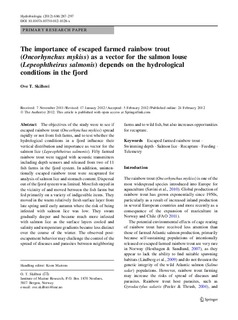The importance of escaped farmed rainbow trout (Oncorhynchus mykiss) as a vector for the salmon louse (Lepeophtheirus salmonis) depends on the hydrological conditions in the fjord
Journal article, Peer reviewed
Permanent lenke
http://hdl.handle.net/11250/109086Utgivelsesdato
2012-02-24Metadata
Vis full innførselSamlinger
- Articles [3012]
Originalversjon
10.1007/s10750-012-1028-xSammendrag
The objectives of the study were to see if escaped rainbow trout (Oncorhynchus mykiss) spread rapidly or not from fish farms, and to test whether the hydrological conditions in a fjord influence their vertical distribution and importance as vector for the salmon lice (Lepeophtheirus salmonis). Fifty farmed rainbow trout were tagged with acoustic transmitters including depth sensors and released from two of 11 fish farms in the fjord system. In addition, unintentionally escaped rainbow trout were recaptured for analysis of salmon lice and stomach content. Dispersal out of the fjord system was limited. Most fish stayed in the vicinity of and moved between the fish farms but fed primarily on a variety of indigestible items. They moved in the warm relatively fresh surface layer from late spring until early autumn where the risk of being infested with salmon lice was low. They swam gradually deeper and became much more infested with salmon lice as the surface layers cooled and salinity and temperature gradients became less distinct over the course of the winter. The observed post-escapement behavior may challenge the control of the spread of diseases and parasites between neighboring farms and to wild fish, but also increases opportunities for recapture.
